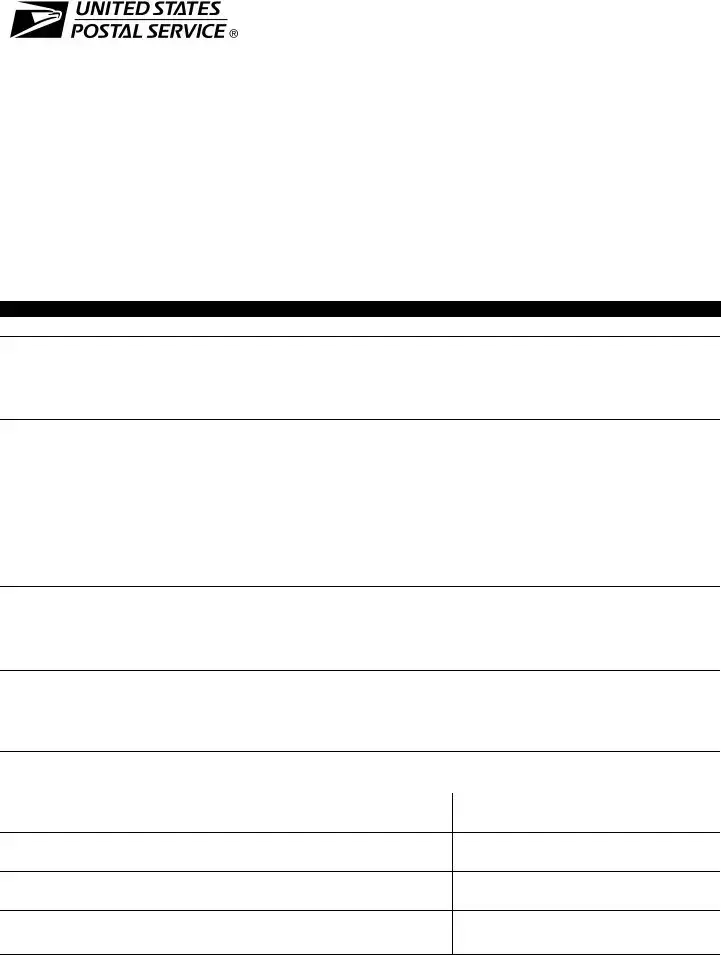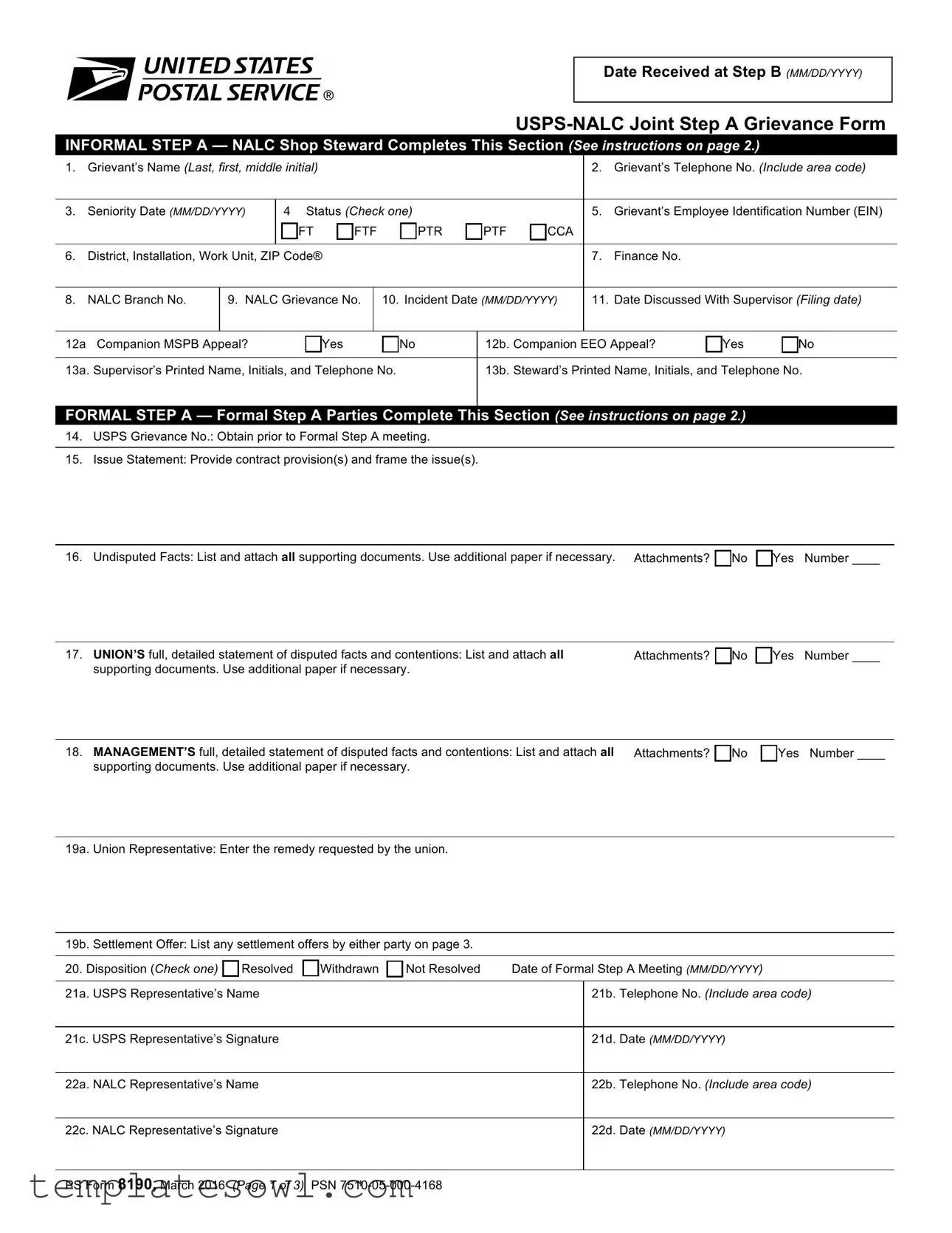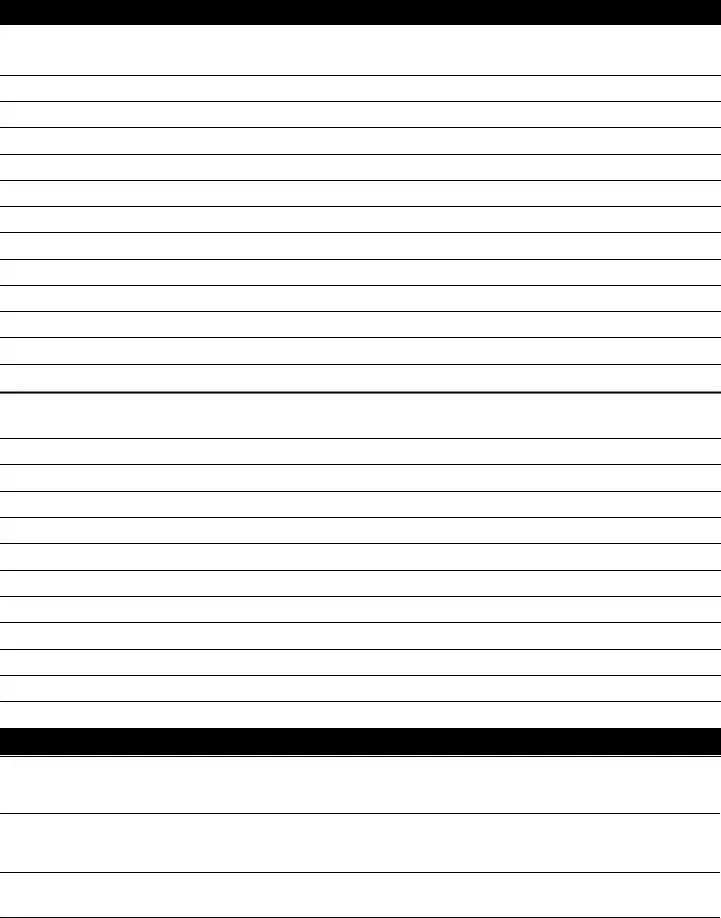
|
|
|
|
|
|
|
|
|
Date Received at Step B (MM/DD/YYYY) |
|
|
|
|
|
|
|
|
|
|
|
|
|
|
|
|
|
|
USPS-NALC Joint Step A Grievance Form |
INFORMAL STEP A — NALC Shop Steward Completes This Section (See instructions on page 2.) |
|
|
1. |
Grievant’s Name (Last, first, middle initial) |
|
|
|
|
2. |
Grievant’s Telephone No. (Include area code) |
|
|
|
|
|
|
|
|
|
|
|
3. |
Seniority Date (MM/DD/YYYY) |
4 Status (Check one) |
|
|
|
5. |
Grievant’s Employee Identification Number (EIN) |
|
|
|
□ FT □ FTF |
□ PTR |
□ PTF □ CCA |
|
|
|
|
|
6. |
District, Installation, Work Unit, ZIP Code® |
|
|
|
|
7. |
Finance No. |
|
|
|
|
|
|
|
|
|
|
|
|
|
8. |
NALC Branch No. |
9. NALC Grievance No. |
|
10. Incident Date (MM/DD/YYYY) |
11. |
Date Discussed With Supervisor (Filing date) |
|
|
|
|
|
|
|
|
|
|
|
|
|
12a |
Companion MSPB Appeal? |
□ Yes |
|
□ No |
|
12b. Companion EEO Appeal? |
□ Yes |
□ No |
13a. Supervisor’s Printed Name, Initials, and Telephone No. |
|
13b. Steward’s Printed Name, Initials, and Telephone No. |
|
|
|
|
|
|
|
|
|
|
|
|
|
|
FORMAL STEP A — Formal Step A Parties Complete This Section (See instructions on page 2.)
14.USPS Grievance No.: Obtain prior to Formal Step A meeting.
15.Issue Statement: Provide contract provision(s) and frame the issue(s).
16. Undisputed Facts: List and attach all supporting documents. Use additional paper if necessary. Attachments? □ No □ Yes Number ____
17. UNION’S full, detailed statement of disputed facts and contentions: List and attach all |
Attachments? □ No □ Yes Number ____ |
supporting documents. Use additional paper if necessary. |
|
18. MANAGEMENT’S full, detailed statement of disputed facts and contentions: List and attach all Attachments? □ No □ Yes Number ____
supporting documents. Use additional paper if necessary.
19a. Union Representative: Enter the remedy requested by the union.
19b. |
Settlement Offer: List any settlement offers by either party on page 3. |
|
20. Disposition (Check one) □ Resolved □ Withdrawn □ Not Resolved |
Date of Formal Step A Meeting (MM/DD/YYYY) |
21a. |
USPS Representative’s Name |
21b. Telephone No. (Include area code) |
21c. USPS Representative’s Signature
22a. NALC Representative’s Name
22b. Telephone No. (Include area code)
22c. NALC Representative’s Signature
PS Form 8190, March 2016 (Page 1 of 3) PSN 7510-05-000-4168
Instructions
If the initial filing discussion between the steward (and/or employee) and the supervisor at Informal Step A does not resolve the grievance, the union steward may appeal the grievance by:
Completing the Informal Step A section at the top of page 1;
Obtaining the supervisor’s initials in Item 13; and
Forwarding the form along with all relevant documents that were shared and discussed at the Informal Step A meeting to union and management Formal Step A representatives within 7 days of the discussion.
INFORMAL STEP A — NALC Shop Steward Completes This Section
Item Explanation
1–9 Self-explanatory. All items are essential.
10Enter the date when the event causing the grievance occurred or when the employee or union first became aware of the event.
11Enter the date the employee and/or the union first discussed the grievance with the immediate supervisor at Informal Step A. This is the Step A filing date.
12a Determine whether the grievant has filed an MSPB appeal on the same issue. Indicate “yes” or “no.”
12b Determine whether the grievant has filed an EEO appeal on the same issue. Indicate “yes” or “no.”
13a To be completed by supervisor, whose printed name and initials confirm the date of the Informal Step A discussion.
13b To be completed by steward, whose printed name and initials confirm the date of the Informal Step A discussion.
FORMAL STEP A — Formal Step A Parties Complete This Section
Item Explanation
14Management Representative: Obtain the Grievance Arbitration Tracking System (GATS) number before the Formal Step A meeting. If necessary, call District Labor Relations for assistance. Record GATS number.
15Frame the issue statement in the form of a question. For example:
Was there just cause for the letter of warning dated 7/15/2011 issued to the grievant for unsatisfactory work performance, and if not, what is the appropriate remedy?
Did management violate Article 8.5.G when the grievant was required to work overtime on 8/15/2011, and if so, what is the appropriate remedy?
List specific contractual or handbook provisions that apply to the grievance.
If discipline is involved:
Always indicate the type of discipline (letter of warning, 7-day suspension, indefinite suspension, etc.) in the issue statement.
The union steward may write a suggested issue in Item 15 when appealing to Formal Step A. The parties at Formal Step A are responsible for defining the issue as they see fit.
Note: If the grievance is resolved at Formal Step A, skip to Item 20, note the principles of the agreement, and complete items 21–22. If the grievance is not resolved at Formal Step A, complete Items 16 through 22.
16Management and/or Union Representative: List all relevant facts not in dispute.
17Union Representative: List any facts in dispute based on your understanding of the facts. Provide concise, descriptive statements outlining the union’s position on the grievance.
18Management Representative: List any facts in dispute based on your understanding of the facts. Provide concise, descriptive statements outlining managements’ position on the grievance.
19a Union Representative: Enter the remedy requested by the union.
19b Management and/or Union Representative: On page 3, list any settlement offers made at Formal Step A.
20Management and/or Union Representative: Note whether the case is resolved, withdrawn, or not resolved. If resolved, note the principles of the agreement.
21–22 Formal Step A parties must enter names, telephone numbers, signatures, and date form is completed.
PS Form 8190, March 2016 (Page 2 of 3)
USPS-NALC Joint Step A Grievance Form
FORMAL STEP A — Formal Step A Parties Complete This Section
19b. Management Settlement Offer (if any)
19b. Union Settlement Offer (if any)
Formal Step A Parties – Provide Mailing Address
USPS Formal Step A (Print street, city, state, and ZIP Code®)
NALC Formal Step A (Print street, city, state, and ZIP Code)
NOTE: If grievance ultimately goes to arbitration, this page MUST be removed from the file prior to submitting the case to the arbitrator.
PS Form 8190, March 2016 (Page 3 of 3)



